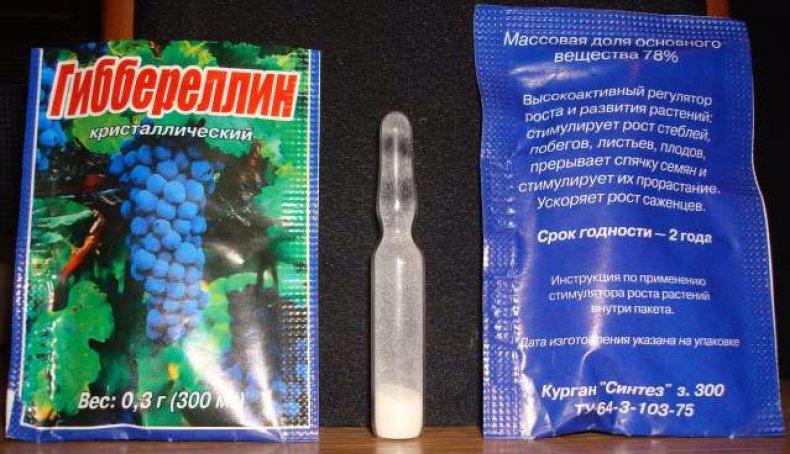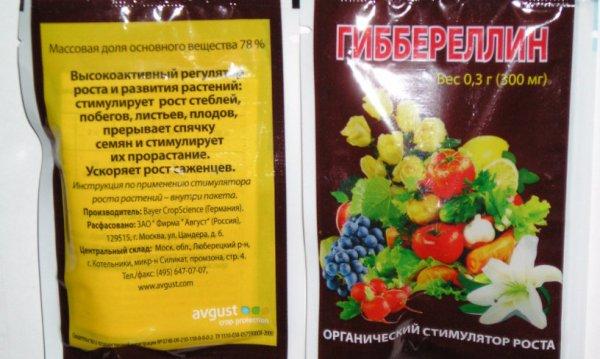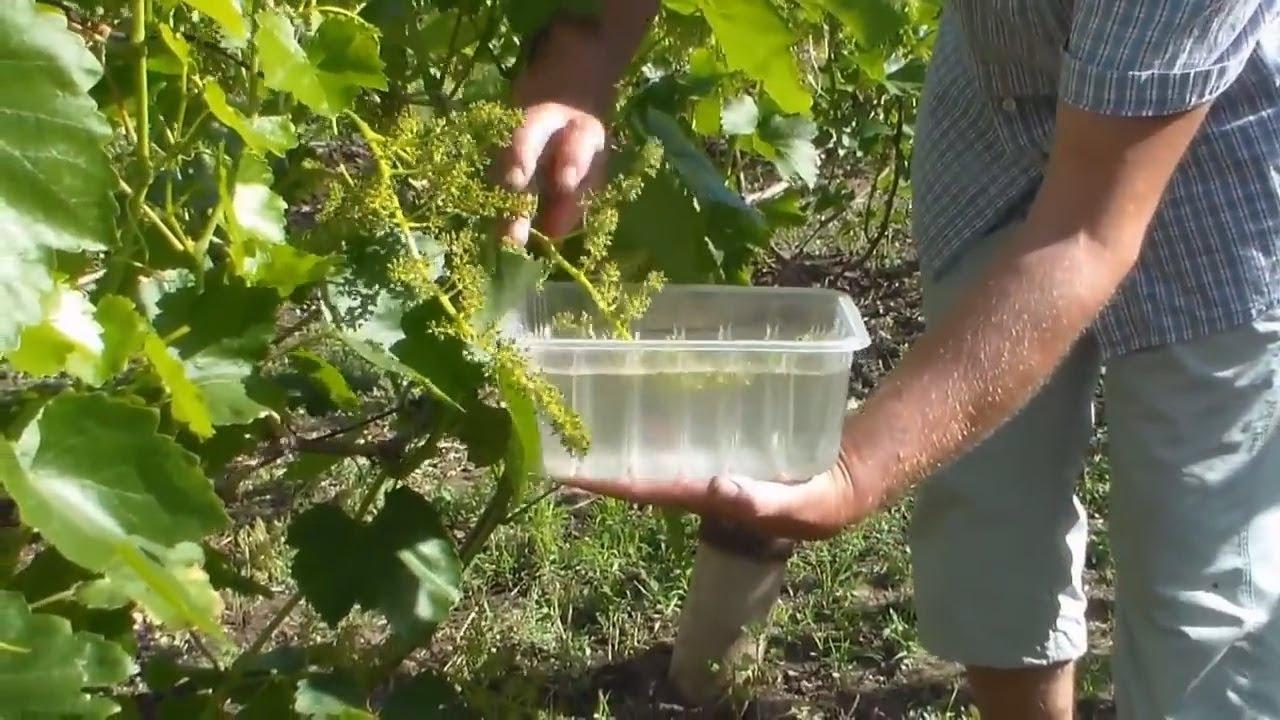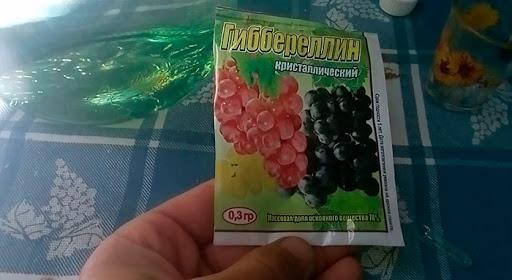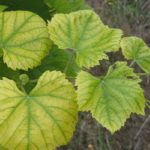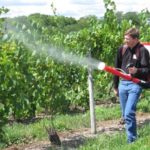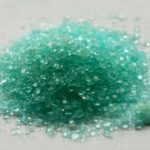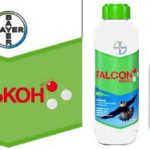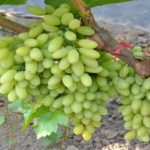Plants produce their own hormones that affect the division of cells in stems, leaves and fruits. As a result of selection, hybrid grape varieties often have sterile pollen in their inflorescences. They require additional pollination in order for full clusters to ripen. One of the effective means of increasing yield for unisexual grapes is gibberellin.
What is gibberellin?
Gibberellin is a hormone obtained microbiologically from a fungus.The drug is an analogue of the natural phytohormone produced by grape seeds after the formation of the ovary. Artificial gibberellin is not an alternative to natural pollination. The functional purpose of the drug is to stimulate berry growth.
If pollination of the bud does not occur during the flowering of the vine, then the seed does not form in the ovary. As a result, the berries do not grow and do not gain mass, which leads to the ovaries falling off and the fruits to peas in the bunch. Such situations are typical for seedless varieties and same-sex hybrid forms.
The drug was developed more than 20 years ago for the treatment of vineyards of sultanas. Later, gibberellin began to be used on grapes with functionally female flowers. The hormone, getting on the skin of the ovary, is absorbed into the berry and causes increased metabolism without the formation of seeds.
When treating the vine at the flowering stage, the substance gets onto the stamens, subsequently having a positive effect on the weight and size of the berries, the appearance of the bunch, also without the formation of seeds. Large grapes in clusters without seeds (not raisins) are a consequence of treating the vine with gibberellin.
Advantages and disadvantages
The use of gibberellin increases the yield of unisexual grapevines and the sultana variety by 1.5-2 times. The use of a phytostimulant is especially important under weather conditions unfavorable for pollination: in cloudy, cool, rainy weather.
Other advantages of using a phytohormonal agent:
- improving the presentation of grape bunches;
- acceleration of berry ripening by 5-7 days;
- increase in sugar content;
- improved keeping quality.
The drug is not toxic to humans, animals and insects. When processing the vineyard, protective equipment for hands and respiratory organs is not required.
The disadvantage of the drug is the lack of exact dosage for each variety. For this reason, grapevines of different varieties should not be sprayed with the same concentration of phytohormone. To obtain an increase in vine productivity, an exact dosage is required, determined experimentally.
Treatment should be carried out in the evening to prolong the absorption of the hormone into the membranes of flowers and ovaries. It takes 6-8 hours for plant tissues to fully absorb the stimulant. Rainy weather during this period reduces the effect of treatment. The procedure needs to be repeated.
Instructions for use of the drug for grapes
Gibberellin is available in the form of a white powder, packaged in plastic bags. The weight of one sachet is 300 milligrams. The average norm for a single-sex variety is 25-30 milliliters per 1 liter. For seedless varieties without seeds, the norm is doubled/tripled.
The inflorescences are sprayed or, for better contact with the hormone, dipped into a container with a solution. The procedure is carried out twice during flowering (in the middle and end) and a week after the end. Load normalization is carried out after the formation of bunches.
In the first year of using the hormone, the dosage is selected experimentally by spraying grape inflorescences with solutions of different concentrations. At the end of fruiting, determine the optimal rate of alcohol solution per 1 liter of water.
Contraindications for use
The phytohormonal agent is not recommended for use on bisexual varieties, since it does not have a significant effect on the increase in yield. Excessive concentration for seedless varieties and same-sex hybrids leads to compaction of the clusters.
Too tight a fit of the berries causes them to crack and develop gray rot.
Caring for the crop after treatment
After spraying with gibberellin, plants require intensive care: watering, fertilizing, removing weeds. Accelerated metabolism requires an increased supply of nutrients.
The nuances of storing gibberellin
Dry gibberellin is stored according to the conditions specified by the manufacturer. An alcohol solution in a glass container retains its working properties for an unlimited period. The water-alcohol solution is suitable for use for no more than 3 days.
Analogs
To increase the yield and marketability of table grape varieties (hybrid unisexual forms and sultanas), different variants of gibberellins are used. The phytohormone “Gibberellin” contains gibberelic acid A3.
Phytostimulants containing several varieties of gibberellins and additional components are available for sale:
- "Gibbersib." The active ingredient is a combination of gibberellins A3, A7.
- "The ovary is universal." The active ingredient is sodium gibberellic acid of high concentration.
- "Bud". The active ingredient is high concentration sodium gibberellins in combination with humates and microelements.
Fruit-forming preparations “Universal Ovary” and “Bud” are used not only for vineyards, but also for growing vegetables, flowers, and fruit trees.

